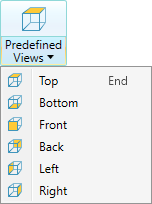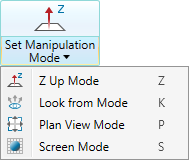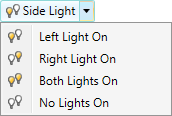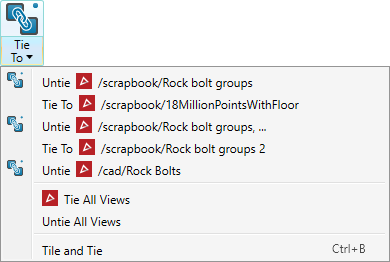View window toolbars
The View window toolbar is used to modify the display of data in the View window. The tools do not change the data itself.

Action plane toolbar
The action plane toolbar is used to
control the action plane in the
View window. Click on the image
for details.

Stereonet toolbar
The stereonet toolbar is used to control and modify a stereonet, when it is displayed in the View window. Click on the image for details.
Refer to the table below for descriptions of the remaining individual icons and their functions, as well as shortcut keys.
| Icon | Description | Shortcut | |
|---|---|---|---|
|
Predefined views
|
Predefined views — Provides a choice of views of the scene from the main orthogonal directions aligned with the axes - Top, Bottom, Front, Back, Left and Right — The command provides two-stage functionality, described below:
|
End |
|
|
Zoom to selection — The view window will zoom to include all the selected objects (without changing the camera direction). |
L |
||
|
|
Set camera view point — Displays the data from a defined position, towards a selected orientation.
|
Shift + K | |
|
Set centre of rotation — Moves the centre of rotation. Click on the icon then in the new location. When rotating a view, the centre of rotation is at the position of the axes in the View window. Tip: If the axes is blocking data from view, right-click and select Show axes to deselect it. Select it again to redisplay the axes. |
C |
||
|
Set manipulation mode
|
Set manipulation mode — Four manipulation modes are available to manipulate the view of the data.
|
Z K P S |
|
|
|
Set projection mode |
Set projection mode — Toggles between orthographic and perspective projection.
|
8 |
|
|
Select all visible data — Selects all objects or primitives (based on the current selection mode). |
Ctrl + A |
|
|
Invert selection — Changes selection to all visible data that was not selected. |
I |
||
|
|
Surface render mode
|
Surface render mode — Switches the rendering between solid, wireframe and points display. The selection effects all objects in the view window. |
G |
|
|
Set lighting state
|
Set lighting state — Change the number of lights and light position(s) to alter scene lighting and subsequent shadow display. Toggle left light. Toggle right light. |
Alt + 4 Alt + 5 |
|
|
Headlight toggle on / off |
Headlight — Turns the headlight on and off. The Headlight is a light aligned permanently with the camera direction. |
Alt + 3 |
|
|
Coordinate grid toggle on / off |
Coordinate grid — Toggle display of coordinate grid. The grid is viewable only from above (looking down z axis) when in orthographic mode. The grid is auto-scaling and displays basic dimensions. More |
|
|
|
The action plane provides a mechanism to help place points in 3D space as well as set up a convenient 2D plane to perform 2D functions on. More |
||
|
Export to PDF / U3D
|
Export to PDF — Creates a 3D PDF for easy distribution of data. Export to U3D — Creates a Universal 3D file of the current view. More |
||
|
Render a high resolution image of the view — High resolution screen capture. More |
|||
|
Display animation editor — Set up and render animated scenes including data. More |
|||
|
|
Visibility editor — Displays a list of the contents of the View window. These may be hidden and redisplayed. Checking the tick-box beside an object's name toggles its visibility - on or off. By default, the Visibility editor appears as a panel on the right side of the View window. It can, however, be dragged and floated if preferred. Dragging it towards the right edge of the View window again will re-insert the Visibility editor to its default position. More |
V |
|
|
|
Juxtaposition View — Splits the view in half along the visibility editor. One half will show the selected view and the other half the un-selected view. More |
||
|
|
Ctrl + B | ||










